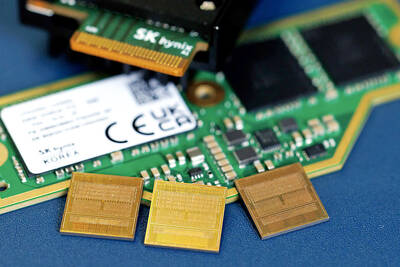Vice Premier Lin Hsin-yi (林信義) yesterday made his second inspection tour of the Nanotechnology Research Center at the Industrial Technology Research Institute (工研院) in Hsinchu, calling for greater government funding.
Lin said that the government has increased nanotechnology research funding to NT$23.17 billion (US$665.8 million) until 2008, up 20.68 percent from an original estimate of NT$19.2 billion.
"But approximately US$100 million annually is still not enough to develop the revolutionary sector -- where Taiwan's future economic miracle lies -- compared to the world's annual US$4 billion [invested in the sector,]" Lin said.
He encouraged the center to seek strategic alliances with the private sector, sharing capital, technological resources and talent to help upgrade the nation's industries -- both in the traditional and high-tech sectors -- as soon as possible.
According to accompanying government officials from the Cabinet-level Council for Economic Planning and Development, Japan is expected to allocate US$1 billion per year on nanotech research, while the US will spend US$750 million per year and West European countries are injecting US$1.2 billion between last year and 2006.
Taiwan, on the other hand, is catching up with South Korea, which spent US$166 million last year, and China, which plans to spend a total of US$300 million between 2001 and 2005 on nanotechnology research.
Despite being cash-strapped, the center envisions a bright future.
The institute's Executive Vice President Bob Yang (楊日昌) said world production value in the nanotechnology industry, which now sits at US$1 trillion, will grow 13-fold between 2005 and 2010, while the scope of its application is expected to increase by 25 times.
"The technology's applications in optoelectronics, where Taiwan enjoys a competitive edge, will expand, greatly benefiting the nation's economy," Yang said.
He also downplayed competition from China, reasoning that Taiwan controls more sophisticated technologies.
Electronics, advanced displays, photonics and high-density storage will be the center's major areas of focus for nanotechnology applications, he said.
Institute President Shih Chintay (史欽泰) said the center puts equal effort into nanotechnology's commercialization, which will soon become readily available to traditional industries, and on long-term exploratory research, that is expected to provide a boost to the biotechnology, semiconductor and information-technology sectors within the next five to 10 years.
Liu Yung-sheng (劉容生), the director of the Institute of Optoelectronics, said the government plans to replace traffic lights and street lamps nationwide with nanotechnology-applied light-emitting diodes, which will cost NT$4.6 billion to install, but is expected to save NT$9.6 billion in electricity in only five years.

Nvidia Corp chief executive officer Jensen Huang (黃仁勳) on Monday introduced the company’s latest supercomputer platform, featuring six new chips made by Taiwan Semiconductor Manufacturing Co (TSMC, 台積電), saying that it is now “in full production.” “If Vera Rubin is going to be in time for this year, it must be in production by now, and so, today I can tell you that Vera Rubin is in full production,” Huang said during his keynote speech at CES in Las Vegas. The rollout of six concurrent chips for Vera Rubin — the company’s next-generation artificial intelligence (AI) computing platform — marks a strategic

REVENUE PERFORMANCE: Cloud and network products, and electronic components saw strong increases, while smart consumer electronics and computing products fell Hon Hai Precision Industry Co (鴻海精密) yesterday posted 26.51 percent quarterly growth in revenue for last quarter to NT$2.6 trillion (US$82.44 billion), the strongest on record for the period and above expectations, but the company forecast a slight revenue dip this quarter due to seasonal factors. On an annual basis, revenue last quarter grew 22.07 percent, the company said. Analysts on average estimated about NT$2.4 trillion increase. Hon Hai, which assembles servers for Nvidia Corp and iPhones for Apple Inc, is expanding its capacity in the US, adding artificial intelligence (AI) server production in Wisconsin and Texas, where it operates established campuses. This

Garment maker Makalot Industrial Co (聚陽) yesterday reported lower-than-expected fourth-quarter revenue of NT$7.93 billion (US$251.44 million), down 9.48 percent from NT$8.76 billion a year earlier. On a quarterly basis, revenue fell 10.83 percent from NT$8.89 billion, company data showed. The figure was also lower than market expectations of NT$8.05 billion, according to data compiled by Yuanta Securities Investment and Consulting Co (元大投顧), which had projected NT$8.22 billion. Makalot’s revenue this quarter would likely increase by a mid-teens percentage as the industry is entering its high season, Yuanta said. Overall, Makalot’s revenue last year totaled NT$34.43 billion, down 3.08 percent from its record NT$35.52

OPPORTUNITY: Supply of conventional DRAM chips tightened after the world’s major memory makers focused on manufacturing chips utilized in AI servers DRAM chipmaker Nanya Technology Corp (南亞科技) yesterday reported a spike in revenue for last month, as severe supply constraints prompted chip price hikes, almost doubling the company’s annual revenue last year from the previous year. Revenue soared 444.87 percent last month to NT$12.02 billion (US$381.4 million), from NT$2.21 billion a year earlier. That brought fourth-quarter revenue to NT$30.17 billion, from NT$6.58 billion for the same period in 2024. On a quarterly basis, revenue jumped 60.65 percent from NT$18.78 billion. Last year, revenue soared 95.09 percent to NT$66.59 billion from NT$32.13 billion in 2024, the company said. Supply of conventional DRAM